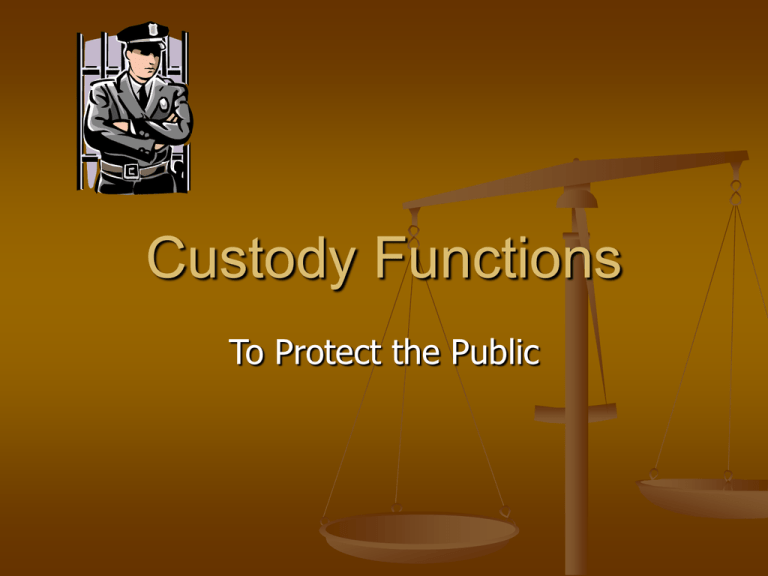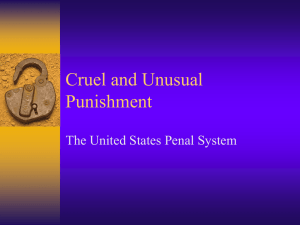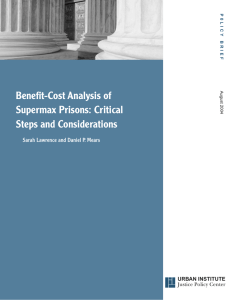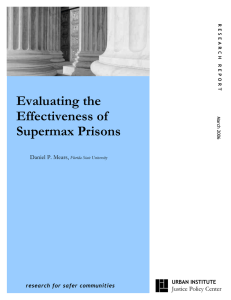Custody Functions
advertisement

Custody Functions To Protect the Public Vocabulary Bureaucratic Control Custody General Population Graduated Release Correctional Officers “Screws” Unionization “Blue Flu” Total Institution Prisonization Lockdowns Count Sally Port Prison Rules Contraband Frisk Search Vocabulary Strip Search “keester” Shakedown Escape Electrified Fence Paramilitary model Unit team Management Bureaucratic Control Prevailing management climate for correctional institutions Inmates controlled by: Coercive rules that prohibit certain behavior Punishment when rules are broken Punishment is swift and equal. Documented rules, regulations and procedures protects bureaucratic organizations Bureaucratic Control Inmates are faceless commodities that are Housed Moved Worked What is a problem with this type of organization model? Custody The level of immediate control exercised over offenders within correctional institutions Levels: Supermax Maximum or Close Medium Minimum Supermax http://www.cbsnews.com/ Supermax "Supermax" is short for "super-maximum security.“ It is a place designed to house violent prisoners or prisoners who might threaten the security of the guards or other prisoners. "the worst of the worst" solitary confinement and sensory deprivation will bring about "behavior modification." Supermax Prisoners are locked into small cells for approximately 23 hours a day. They have almost no contact with other human beings. No contact visits: prisoners sit behind a Plexiglas window. no group activities: no work, no educational opportunities, no eating together, no sports, no getting together with other people for religious services, and no attempts at rehabilitation. Supermax Phone calls and visitation privileges are strictly limited. Books and magazines may be denied and pens restricted. TV and radios may be prohibited or, if allowed, are controlled by guards. Prisoners have little or no personal privacy. Supermax What could be wrong with Supermax prisons? Maximum or Close Security Prisons Very close to Supermax in management styles Very little contact with other inmates, but more than Supermax Still high risk prisoners Guard to inmate ratio quite high 1 guard to 3 to 4 inmates Medium and Minimum Security Less Risky prisoners Difference between medium and minimum security custody is the presence of a high wall or fence and armed guard towers surrounding medium. Decrease ratio of guard to inmate 1 guard to 8 to 12 inmates General population All prisoners not under special custody control Graduated Release The process of moving an inmate to less secured jobs in the prison prior to release. Three to six months before release Grounds keeping, sweeping, clean up, driving from location to location AKA “trustee” Correctional Officers Better trained and better educated than “prison guards” of old Division who performs advanced work involving the direct supervision of offender in their daily assigned duties including the responsibility of preventing escapes and maintaining discipline in conformance with strict rules, regulations, and standard operating procedures Correctional Officers Also known as Screws Guards Jailers Prison Guards BOSS Hacks Line Staff Correctional Officers By the numbers 381,000 correctional officers in 2005 worked at federal, state, and local adult facilities Female officers – 23 % Male officers – 77% Over 30 % were non-white Unionization Unions have made their way into Prisons Guards join unions to protect themselves from litigation, improve working conditions, and better pay Blue Flu The practice by uniformed officers of taking sick leave en masse to back up their demands of improved working conditions, salary increments, and other items on the unions agenda, since most jurisdictions will not allow government employees to strike. Total Institutions Prisons The residents every movement, activity, moment, and option are carefully regulated by the correctional administrators. Prisonization The process of learning how to exist in prison The appropriate attitudes and behaviors Norms of prison life Process leads to adoption of the folkways, mores, customs, and general culture of the prison Prisonization Handed down from prisoner to prisoner Learn codes and roles Loyalty to other inmates Maintenance of calm ( keep cool) Avoidance of trickery or fraud Manliness (don’t complain) Quick wittedness in prison dealing (don’t trust the guards) Prisonization Inmates who conform to those expectation are accepted into the prison system Inmates who do not conform to those expectations become outcasts and are referred to by various negative words such as rat, snitch, merchant, fink, and punk. Prisonization - Gangs Seven Major Gangs Texas Syndicate Began Mid 1970’s in California Mostly Hispanic inmates Strict rules Violation of rules may result in death California, New Mexico, Arizona, Florida, Illinois, and The Federal Bureau of Prisons http://davadnai.users.omniglobal.net/ts.html Prisonization – Gangs Mexikanemi MM – one of the fastest growing gangs in Texas prisons Aztec for “free or liberated Mexican” Originated in 1980’s Hierarchical in nature http://davadnai.users.omniglobal.net/eme.ht ml Prisonization – Gangs Aryan Brotherhood of Texas Started 1980’s A council, or steering committee, provides leadership. This committee approves prospective members, makes decisions on gang rules, and is responsible for resolving problems between members. The committee is also the authority, which issues orders for "hits" or "contracts.“ http://davadnai.users.omniglobal.net/abt.html Prisonization – Gangs Texas Mafia White Inmates Motorcycle gangs Narcotics The Texas Mafia and the Texas Syndicate have very close ties and they refer to each others as cousins. Prisonization – Gangs Nuestro Camales Small but violent Ties to Texas Syndicate Hermanos de Pistoleros Latinos Small but Violent Ties to Texas Syndicate http://davadnai.users.omniglobal.net/hpl.html Raza Unida Small but Violent Ties to Texas Syndicate http://davadnai.users.omniglobal.net/ru.html Prisonization – Gangs MS-13 Mara Salvatrucha Formed 1980’s From El Salvador In 33 states Nearly 10,000 members in USA 700,000 overall Not much known about them Very dangerous http://www.cbsnews.com/stories/2005/12/01/60minutes/main1090941_page2.shtml Gang signs http://zimmer.csufresno.edu/~haralds/htm lfiles/gang-signs.html http://www.knowgangs.com/gang_resourc es/handsigns/menu_002.htm Lockdown A temporary suspension of ordinary and routine activities. As a general rule, offenders are confined to their cell or dormitory. Count Principle method of determining the prisoner’s whereabouts. Can be done as often as every two hours Sally Port An area enclosed by a double gate One door opens Someone enters The first door closes A search can occur The second door opens The person leaves Prison Rules Behavior guidelines set up by correctional administrator for the inmates to follow. Violations of prison rules are more likely in larger prisons Race makes no difference in rates of rule violations Women have a higher level of rule violations then men Contraband Any item that could be used to break an institution’s rule or to assist in escape Frisk Search A search used when prisoners enter or leave the institution and when institutional personnel suspect a prisoner may be hiding contraband on their person. Strip Search Search conducted when a prisoner is suspected of having access to contraband hat can be secreted on the body or in a body cavity, and a frisk reveals nothing Conducted in an area where the inmate will not be ridiculed Keester Internal transportation of contraband Shakedown Searching a whole cell or cell block for contraband Escape Flight of a confined person from an institution 2003 – 3300 escapes in USA Most returned quickly Electrified Fence A metal fence that electrical current flows through it in order to prevent escape. Paramilitary Model Adoption of militaristic organizational structures and procedures in corrections Uniforms, titles, and procedures of custody personnel Unit Team Management The management idea that all custodial employees from cell block, tank, pod, or wing work as a team to provide custody, support, and rehabilitative services in a single coordinated package.









